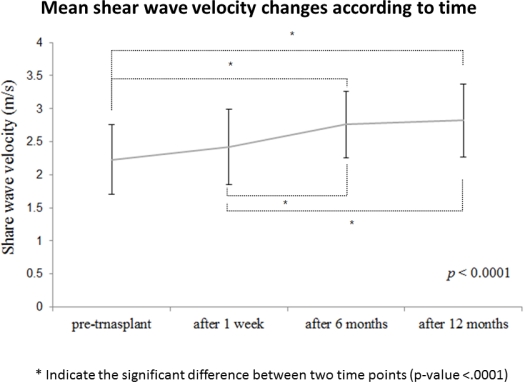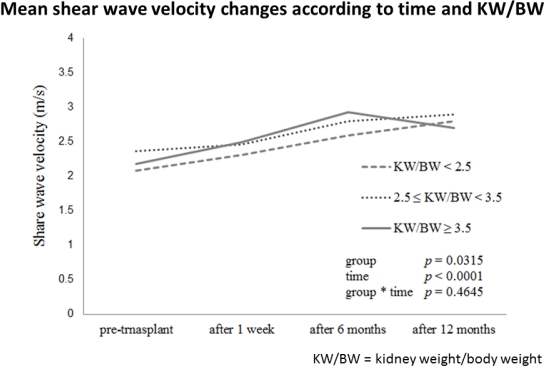Acoustic Radiation Force Impulse Measurement in Renal Transplantation
1Department of Transplantation Surgery, Yonsei University Health System, Seoul, Republic of Korea
2Department of Surgery, Sungkyunkwan University School of Medicine, Seoul, Republic of Korea
3Biostatistics Collaboration Unit, Yonsei University College of Medicine, Seoul, Republic of Korea
4Department of Radiology, Yonsei University Health System, Seoul, Republic of Korea.
Meeting: 2015 American Transplant Congress
Abstract number: B235
Keywords: Graft function, Kidney transplantation, Nephron mass, Screening
Session Information
Session Name: Poster Session B: Radiology/Renal Artery Stenosis
Session Type: Poster Session
Date: Sunday, May 3, 2015
Session Time: 5:30pm-6:30pm
 Presentation Time: 5:30pm-6:30pm
Presentation Time: 5:30pm-6:30pm
Location: Exhibit Hall E
Background
Allograft biopsy is the definitive diagnostic methods for evaluation of renal dysfunction, but there is always the risk of complications. Efforts to develop a notable alternative to biopsy have continued. The aim of this study was to explore the clinical implication of acoustic radiation force impulse (ARFI) technique.
Patients and Methods
A total of 91 patients who received a living donor renal transplantation between September 2010 and January 2013 were included in this prospective study. We measured the shear wave velocity (SWV) by ARFI at baseline and at predetermined time points (1 week, 6 months, and 12 months after transplantation). Protocol biopsies were performed at 12 months.
Results
Instead of reflecting renal fibrosis, the SWV value was related to the time elapsed after transplantation. Mean SWV value increased continuously during 1 year (p<0.001). In addition, there was no correlation between SWV value and serum creatinine in mixed model analysis considering the time of inspection. The changes of SWV showed different pattern according to the kidney weight to bodyweight ratio (KW/BW). The mean SWV of patients with KW/BW <3.5 g/kg was continuously increasing for 12 months, on the other hand, that of KW/BW ≥3.5 g/kg group was decreasing after 6 months.


Conclusion
SWV value was related to the time elapsed after transplantation. There was no significant correlation between SWV value with renal fibrosis or renal dysfunction. Hemodynamic factors could be impact on the SWV value.
To cite this abstract in AMA style:
Lee J, Lee J, Lee A-l, Ma B, Oh Y, Huh K, Kim M, Kim S, Kim Y, Joo D. Acoustic Radiation Force Impulse Measurement in Renal Transplantation [abstract]. Am J Transplant. 2015; 15 (suppl 3). https://atcmeetingabstracts.com/abstract/acoustic-radiation-force-impulse-measurement-in-renal-transplantation/. Accessed December 28, 2025.« Back to 2015 American Transplant Congress
